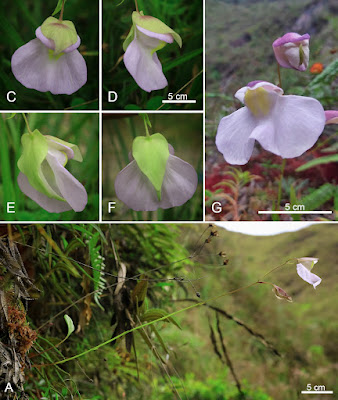 |
| Utricularia amotape-huancabambensis T. Henning, E. Rodr. & J.P. Allen. in Henning, Allen & Rodríguez-Rodríguez, 2021. |
A new species of Utricularia Section Orchidioides: Utricularia amotape-huancabambensis sp. nov. (Lentibulariaceae), endemic to Northern Peru is described and illustrated. It is known from two populations so far, both located in the Province Bongará, Dpto. Amazonas at ca. 2200 m altitude. The new species inhabits the páramo of the low white sandstone plateaus, an extension of the southern branches of the Condor mountain range in the southeastern part of the Amotape-Huancabamba phytogeographic zone. A diagnosis, description, etymology and an identification key covering the Andean and selected similar species of the section are presented. The distribution, habitat, ecology, associated flora, preliminary conservation status, an observed hybridization with sympatric U. unifolia and the affinities of the new species with other related taxa are discussed. The new species is known from two close-by populations in the same region and likely affected by anthropic pressure. Threatening changes in land use, resulting in habitat fragmentation or loss or changing water regimes in the course of climate change will have severe consequences for the sensitive páramo ecosystem and thus the populations of U. amotape-huancabambensis. Therefore, this new spectacular species of Utricularia is preliminarily considered Critically Endangered (CR).
Utricularia amotape-huancabambensis sp. nov. T. Henning, E. Rodr. & J.P. Allen.
Diagnosis: Utricularia amotape-huancabambensis belongs to Utricularia section Orchidioides and is closely related to U. unifolia. It differs from it by having a more robust habit, a broadly ovate to rounded leaf lamina, longer petioles and inflorescences, much larger flowers with a white or slightly lavender corolla and an upper lip slightly longer and wider than the calyx. The spur is terminally curved downwards.
Etymology: The name refers to the Amotape-Huancabamba Zone, the area around the Huancabamba depression, a partial interruption of the Andean mountain range by the Chamaya river drainage system, which occupies large parts of northernmost Peru and the southern tip of Ecuador (Fig. 1). The mosaic landscape in this region is characterized by a remarkable diversity in different habitat types and a corresponding exceptional zoo- and phytodiversity. In particular, the high rate of narrow endemism concentrated in this relatively small area is intriguing and has led to the idea to consider this area a phytogeographical zone of its own right (such as e.g. the Capensis). “A sizable part of Andean biodiversity seems to be concentrated into this relatively small area, which makes effective protection of the diverse habitats of this zone a high priority” (Weigend, 2002). The name of this new species has been chosen to reinforce this demand and encourage Peru and Ecuador to intensify the urgent conservation efforts for the remaining habitats in this otherwise highly fragmented landscape. Both climate change and urban sprawl are massive threats especially to the remaining forest patches. They are home to an unparalleled diversity of flora and fauna, the known extent of which is here complemented by this emblematic species of flowering plant. The name is intended to serve as a hortatory reminder of the unabated destruction of irreplaceable biodiversity in areas such as the Amotape-Huancabamba Zone (Karger et al., 2021) that are both: heavily overexploited while still underexplored.
Tilo Henning, Joshua P. Allen and Eric F. Rodríguez-Rodríguez. 2021. A New Species of Utricularia Sect. Orchidioides (Lentibulariaceae) from the Amotape-Huancabamba Zone of North Peru. Darwiniana. 9(2); 299-311. DOI: 10.14522/darwiniana.2021.92.955

